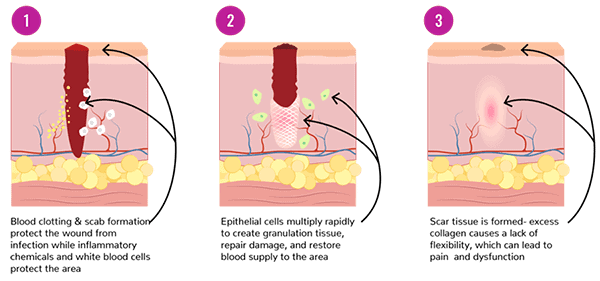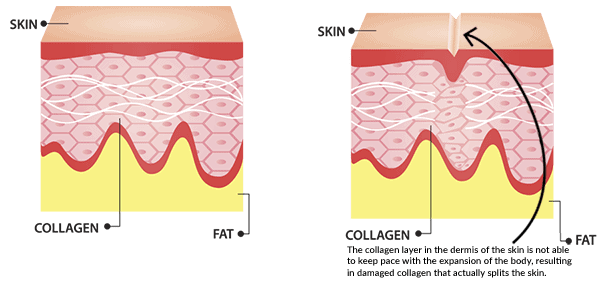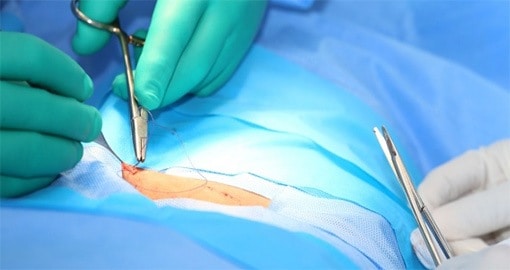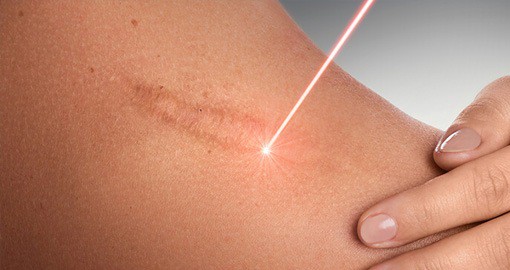
OC 949-428-4500
LA 310-460-2444

Everyone’s been there…
Maybe it’s from falling down, taking a nasty spill, a sports injury, an animal bite, surgery or doing just about anything else, injuries to the body happen. It’s just one of those things. Sometimes these injuries heal up without a problem. Other times the skin will scar, becoming a permanent reminder of the former injury.
However, for those who want to know how to prevent scarring, or reduce the appearance of a scar that is already there, there are several tips and/or scar treatments that can help. By taking these into account, you will not only learn how to prevent new scars from forming, you will also learn how to significantly reduce the appearance of any scars that you may already have.Scarring happens in many shapes and forms. Sometimes these are small facial scars caused by a bad acne breakout. Other times these are long cuts along the body. Depending on the severity of the injury and the deepness of the cut there may be no way to completely prevent scarring from occurring. Other times it is possible to prevent extensive damage and to allow the skin to heal up and return to its natural form.
While some people consider scars cool, most people would prefer not to display these battle scars of past injuries.After an injury to the dermis, which is the thicker layer of skin under the top layer (epidermis), the body will begin to produce new collagen fibers. Collagen is a protein found within the body.
After the injury clots off and crusts into a scab, your body uses this collagen to kick-start the healing process. The tissue forms over the injury, so if there is a large indentation or separation between the current healthy skin, the scar may grow into a different texture and look different from the rest of the skin.
The way a scar develops on the body differs not only from injury to injury but also from person to person. Typically, a scar will look paler (it may not have as much pigment in the new tissue as the current skin) than the surrounding skin.
Some individuals produce more collagen than others, which leads to a raised scar. Younger people are more likely to develop raised scars than flat or sloping scars because their bodies naturally produce more collagen. Those with a naturally darker skin tone also produce more collagen and are more likely to end up with a raised scar.
Stretch marks are actually scars. Most often these stretch mark scars occur during pregnancy or weight gain, but they can also happen during a growth spurt or rapid muscle gain.
Simply stated, the collagen layer in the dermis of the skin is not able to keep pace with the expansion of the body, resulting in damaged collagen that actually splits the skin.
That is why stretch marks can appear just about anywhere. Most commonly they are found around the shoulders and chest, around the back or around the stomach.
As mentioned above, stretch marks form differently than other types of scars. However, it is still possible to treat stretch marks to help reduce their appearance.Timing is everything when it comes to preventing a scar from forming. The best time is right when it happens, when the collagen cells are young. It’s easier to prevent scarring after an injury than it is to remove a scar after it forms.
While someone might not care one way or the other immediately after the injury whether they end up with a scar or not, they may care later on down the road. That is the main reason someone should try to prevent scarring. Once it forms, it becomes that much more difficult (and potentially expensive) to get rid of.First, it is super important to keep your injury out of the sun. The sun is one of the fastest ways to ensure the scar becomes permanent. Since the amount of pigment in the new collagen differs from the rest of the body, it will not react to the sun in the same way as the rest of your skin.
Next, it is important to apply moisturizing lotion to the area. Drinking plenty of water throughout the day is also critical. The newly formed skin in the area needs to stay hydrated. In addition, avoid sodium or beverages high in salt, such as soft drinks and juices, as these items can lead to dehydration.
Finally, if the skin is already scarred or if a new scar is developing, there is one topical treatment that stands above the rest. Cocoa butter cream is one of the best topical treatments as it contains lots of vitamin E. Most skin care products marketed as scar reduction creams have both cocoa butter and vitamin E included as their main ingredients.When a scar slopes in or looks like a pit in the skin this is often due to a mass being removed from under the skin. This is common following a physical trauma or a surgical procedure. There isn’t much that can be done to prevent scars from forming in these situations.
However, there are scar treatments such as revision surgery or subcision that may be able to help reduce the appearance of these types of scars.
Scar revision surgery is a procedure designed to minimize the appearance of a scar. During this procedure the scar tissue is surgically removed and the wound is re-sutured utilizing advanced techniques in wound closure. The end result is a much less noticeable scar that blends more with the surrounding skin.
For raised scars, such as keloid scars, the surgeon will probably not recommend surgery. These types of scars are more likely to keep developing, even after surgery. Trying to remove a raised scar may could end up causing further scaring after the procedure.Sometimes, very complicated scars can develop adhesions, where the scar tissue penetrates down below the skin, like roots that hold the skin down which creates dimpling.
When this happens, a procedure called subcision is used, wherein these adhesions are released, cut through with a special needle that release the adhesions allowing the skin to float freely.
Many different types of scars, created by many different types of events, on many different parts of the body, can be effectively treated with lasers. Usually, newer scars on a person do respond better and faster to treatment than older scars on that same person.
A typical laser scar removal protocol consists of 5 to 7 laser treatment sessions.Dermabrasion, a skincare treatment offered at spas, is another option. The process removes the top layer of skin, exposing the new layer of skin underneath. This can not only help with preventing the development of acne and reduce the appearance of fine lines, but it may help with the appearance of a scar.
Many treatments, and time, will be needed to reduce the appearance of a scar.Microdermabrasion is a type of dermabrasion that is less invasive and can be done every few weeks since it does not remove as much of the skin. This makes it less effective than dermabrasion for reducing the appearance of scarring.
Microdermabrasion is a good procedure to test out before moving on to the more extreme dermabrasion. Especially is you have sensitive skin.Another effective scar treatment are dermal filler injections. This procedure involves injecting a naturally occurring substance, scientifically modified, under the scar to help smooth out the appearance. Dermal fillers are most commonly used to fill in wrinkles, although they can also be used to fill in scars as well.
When there aren’t many other options for reducing the appearance or to prevent the development of scarring, dermal fillers might be an option to consider.Chemical peels are used to primarily for mild scarring such as scarring left over from acne. A chemical solution is used that removes the outer layer of the skin allowing new healthy skin to take its place.
The chemical peel also inflicts trauma to the skin which stimulates the body to produce new healthy collagen. It is this new collagen that fills in the scared areas of the skin.Last but not least, there is microneedling. Microneedling is a procedure wherein tiny holes are punctured in the skin to stimulate the production of new healthy collagen. As we all know, collagen is the body’s natural wrinkle-fighting agent. The microneedling procedure can help with the development of new healthy skin around the scar. This can help fill in the scar, raising it back to the natural level of your skin.
This scar treatment works with finer scars and may not be the best option if you have a thicker, wider scar, or one that is raised.There are numerous “incidents” that can end up causing a scar but there are also many ways to prevent a scar from forming. Knowing how to prevent scarring will help you to keep future “accidents” from turning into a scar. Or, at the very least, keep that scar as small and inconspicuous as possible.
For those worried about their appearance, now you know the necessary steps to prevent the development of a scar after a scab from an injury forms. Be safe out there!Doctors Alice Pien, MD and Asher Milgrom, Phd are established pioneers in the fields of Regenerative Medicine and Skincare. Their expertise ranges from advanced laser systems to HCT/P – Stem Cell medicine. Their medical education and advanced certifications span from medical schools of NY State University, the University of Chicago, to Johns Hopkins, Harvard and UCLA. They approach medicine with the clinical expertise of over 85,000 successful treatments over the past 20 years and significant scientific research resulting in proprietary protocols that they customize for each individual patient.
AMA Regenerative Medicine & Skincare | 1570 Brookhollow Dr., Santa Ana, CA 92705 | 6310 San Vicente Blvd STE 285, Los Angeles, CA, 90048 | Privacy Policy